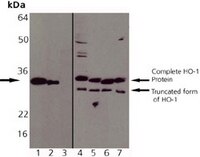374090 Sigma-AldrichAnti-Heme Oxygenase-1 (1-30) Rabbit pAb
Anti-Heme Oxygenase-1 (1-30), rabbit polyclonal, recognizes the ~32 kDa HO-1 protein. Does not cross-react with HO-2. It is validated for use in Western blotting and immunoprecipitation.
More>> Anti-Heme Oxygenase-1 (1-30), rabbit polyclonal, recognizes the ~32 kDa HO-1 protein. Does not cross-react with HO-2. It is validated for use in Western blotting and immunoprecipitation. Less<<Synonyms: Anti-HO-1, Anti-Hsp32
Recommended Products
개요
| Replacement Information |
|---|
주요 사양표
| Species Reactivity | Host | Antibody Type |
|---|---|---|
| Ca, Ht, H, Mk, M, R | Rb | Polyclonal Antibody |
가격 및 재고여부
| 카탈로그 번호 | 재고 정보 | 패킹 | 포장 단위 | 가격(VAT 별도) | 수량 | |
|---|---|---|---|---|---|---|
| 374090-100ULCN |
|
Plastic ampoule | 100 ul |
|
— |
| Product Information | |
|---|---|
| Form | Liquid |
| Formulation | In PBS, 50% glycerol, pH 7.2. |
| Preservative | ≤0.1% sodium azide |
| Quality Level | MQ100 |
| Physicochemical Information |
|---|
| Dimensions |
|---|
| Materials Information |
|---|
| Toxicological Information |
|---|
| Safety Information according to GHS |
|---|
| Safety Information | |
|---|---|
| S Phrase | S: 24/25-36-A09 Avoid contact with skin and eyes. Wear suitable protective clothing. |
| Product Usage Statements |
|---|
| Packaging Information |
|---|
| Transport Information |
|---|
| Supplemental Information |
|---|
| Specifications |
|---|
| Global Trade Item Number | |
|---|---|
| 카탈로그 번호 | GTIN |
| 374090-100ULCN | 04055977191172 |
Documentation
Anti-Heme Oxygenase-1 (1-30) Rabbit pAb MSDS
| 타이틀 |
|---|
Anti-Heme Oxygenase-1 (1-30) Rabbit pAb Certificates of Analysis
| Title | Lot Number |
|---|---|
| 374090 |
References
| 참고문헌 보기 |
|---|
| Maines, M.D. 1988 FASEB J. 2, 2557. Kutty, R.K., et al. 1994. J. Cell Physiol. 159, 371. Yoshida, T., et al. 1988. Eur. J. Biochem. 171, 457. Trakshel, G.M., et al. 1986 J. Biol. Chem. 261, 11131. |








